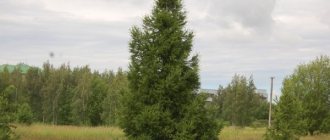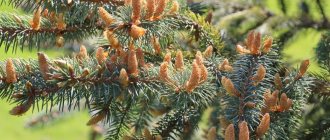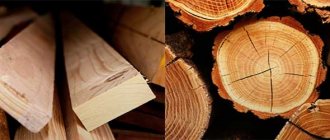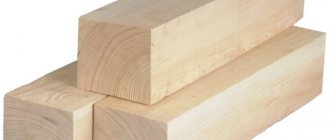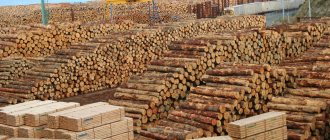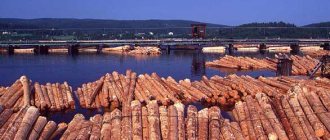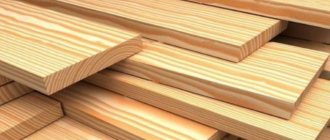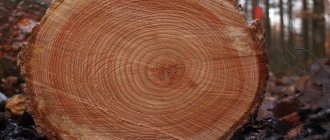Apple wood texture
The apple tree is a sound tree species. The heartwood is red-brown in color, and the sapwood is yellow-pink in color. Often the color of the core is almost the same as the color of the sapwood.
Cross section of an apple tree
The texture of the wood is uniform, the cut surface is decorated with small lines of dark brown color. Curly wood blanks have a beautiful wavy texture. The wood from the root part of the trunk and the blanks from the roots of the apple tree have the same pattern.
Wood species. Apple tree. Texture.
Apple products
Apple wood makes excellent kitchen utensils. Spoons and various spatulas not only look beautiful, but also last for many years.
Various turned products for dry products look great. These are salt shakers, bowls, dessert trays.
Apple tree knife handles are not only beautiful, but also have high performance properties. This wood makes excellent blocks for planes, marking tools (squares, rulers, surface planers), and handles for tools.
Dense apple wood is an excellent material for small carvings. Boxes and turned products that are decorated with fine geometric carvings look very good. Craftsmen make various jewelry from apple trees - pendants, brooches, beads.
Apple wood is used to make small overhead furniture elements. Veneer is used to decorate interiors. Apple parquet lasts for decades, while remaining beautiful.
Thin planks cut from the butt part of an apple tree trunk have a very beautiful wavy pattern. This material is used to make various boxes and snuff boxes.
Recently, cases of exclusive mobile phones, computer monitors, and removable storage devices (flash drives) have begun to be made from apple trees.
More articles from the section Wood processing
Source of the article: https://hobbywood.ru/porody-drevesiny-yablonya/
Apple wood processing
Apple tree wood is quite hard, so it requires a sharp tool for processing. But the cuts come out very clean, it cuts in all directions without chipping.
Works very well on lathes.
Due to its homogeneity, wood can be easily sanded, forming very smooth surfaces for further coating with varnishes and polishes.
It glues easily and can be painted with mordants and stains, acquiring a dark brown color.
Small items can be made from raw wood, as it is easy to cut. But at the same time there is a high probability of cracking of the finished product.
Apple wood is practically not used for bent products.
Structural features, technical properties and application of deciduous scattered vascular species
Deciduous scattered vascular species are represented by birch, aspen, black and gray alder, willow, poplar, Norway maple, small-leaved linden and, in small quantities, some fruit species such as apple, pear, plum, etc.
Birch. Among the various types of birch in the conditions of Belarus, the most widespread species are warty birch and, to a lesser extent, downy birch; their reserve is about 180 million m3. In practice, due to complete identity, warty and downy birch wood is not distinguished.
A tree up to 20–25 m high and up to 80 cm in diameter with a straight, slightly spiny trunk and an ovoid openwork crown. The trunk at a young age is covered with white thin bark; with age, in the lower part of the trunk the bark becomes dark, thick and fissured.
The species is sapwood, having a uniform color of wood throughout the entire cross-section of the trunk, the wood is white with a pinkish tint. Annual layers on all sections are poorly distinguished. When ripe, a false kernel often forms in the middle of the trunk. Wood also often contains veins in the form of brown dots or dashes. The core rays are very narrow, difficult to notice only in a strictly radial section in the form of narrow stripes-dashes of a slightly darker color compared to the main background of the wood.
Birch wood is characterized by fairly high physical and mechanical properties:
- density – 640 kg/m3;
- volumetric shrinkage coefficient – 0.54;
- tensile strength in compression along the fibers – 54 MPa, bending strength – 110 MPa;
- end hardness – 46 N/mm2; - impact strength – 9.3 J/cm2.
However, birch wood has a serious drawback - low resistance to rotting.
Birch wood is used for the production of lumber used in construction, mechanical engineering, the production of furniture, containers, and household products (tool handles, ax handles, shovel handles, etc.). A significant amount of harvested birch wood is used to produce peeled and planed veneer and plywood. Due to its uniform structure, high strength and good ability to absorb adhesives, birch wood is the best material for the production of high-quality ordinary and aircraft plywood, as well as wood laminates. Birch wood is used to make skis, gun stocks, and in textile production - for the manufacture of shuttles, bobbins, and reels. Birch is used for turning work in the production of sports equipment. furniture parts, household items. Since birch wood is odorless, food containers are made from it. High-quality cellulose and the best activated charcoal, acetic acid, furfural and other wood chemical products are obtained from birch. Birch firewood has a high calorific value.
Alder. Two types of alder grow on the territory of the Republic of Belarus - black alder and gray alder with a total reserve of 80 million m3. Black alder is the most widespread and economically important.
Black alder forms clean stands on highly moist soils with running water. It is the second largest wood reserve in the republic among scattered-vascular deciduous species. The black alder tree reaches a height of up to 30 m and up to 70 cm in diameter, has a slender full-woody trunk with dark brown bark.
Alder is a kernel-free species. When freshly cut, the wood is white, but after lying in the air for a short time, it darkens greatly and acquires a red-brown color. The annual layers on a cross section of freshly cut wood are distinguished quite well due to the dark border strip, but on dry wood - poorly. Core rays are of two types: very narrow, invisible in a transverse section, and false-wide, clearly visible in all sections (on the transverse - in the form of light radial lines, on the radial - in the form of curved ribbons, and on the tangential - in the form of narrow dark longitudinal strokes) . Quite often there are veins in the form of brown dashes or streaks.
Alder wood is soft, light, does not dry out much, and is characterized by the following physical and mechanical properties:
- density – 525 kg/m3;
- volumetric shrinkage coefficient – 0.43;
- tensile strength in compression along the fibers - 40 MPa, bending strength - 70 MPa;
- end hardness – 40 N/mm2;
- impact strength – 5.2 J/cm2.
Alder wood has natural antiseptic properties, so it is little susceptible to destruction from fungi and insects. In its round form, alder is used for the construction of temporary and auxiliary buildings and the production of general-purpose lumber. It is used for the manufacture of dry barrels and box containers. Alder imitates mahogany well, so it is a valuable material in furniture production and is used to make sliced veneer. A significant amount of alder is used in the production of plywood. Due to its low dimensional changeability under conditions of variable air humidity, it is used for the manufacture of models in foundries. Along with aspen, it is used for making matches. Alder is also used in the production of cellulose and wood pulp. Waste from sawmilling and woodworking is used to produce fiberboard and other board materials.
In the northern regions of our country, along with black alder, gray alder is found. In terms of the macrostructure of wood, gray alder is practically no different from black alder, however, the density and strength characteristics of gray alder are 15–20% lower compared to black alder. In practice, gray alder is used for the same purposes as black alder.
Aspen is widespread in the republic, its reserve is 22 million m3. An aspen tree is 25–30 m high and sometimes more than 1 m in diameter. The tree trunk is full-wood with a cylindrical crown rounded at the top.
Aspen is a coreless (mature wood) species. The wood along the entire cross-section of the trunk is white with a slight greenish tint, but in the center of the trunk there is often a false core of a grayish-brown color, which over time turns into heart rot. The annual layers are poorly distinguished, but when moistened with water they stand out more clearly due to the slightly yellowish border stripe. The medullary rays are very narrow, the same color as the surrounding wood and therefore cannot be distinguished in any section.
Aspen wood is soft, light, easy to cut, peel and split. The physical and mechanical properties of wood are relatively low:
- density – 485 kg/m3;
- volumetric shrinkage coefficient – 0.41;
- compressive strength along the fibers is 40 MPa. static bending – 80 MPa;
- end hardness – 25 N/mm2;
- impact strength - 8.4 J/cm2.
Round aspen wood is used for temporary and auxiliary buildings, fencing poles. Aspen lumber is used in construction, for the manufacture of jellied and dry barrels and box containers, and household items. Aspen is the main raw material in match production. A significant amount of aspen is also used in the production of plywood. Aspen is the starting material for producing pressed wood. Aspen pulpwood is used to produce cellulose and wood pulp. Aspen bark is a raw material for tar production.
Norway maple. Tree up to 30 m high, up to 1 m in diameter, with an ovoid wide crown. The maple reserve in the republic is insignificant - 0.03 million m3.
Maple is a coreless (sapwood) species, but in the central part of the trunk there is often a false kernel of a greenish-gray color. The wood has a uniform structure, white, sometimes with a pale pinkish or yellowish tint. The annual layers are visible quite well due to the dark border strip. The medullary rays are narrow, but quite distinguishable in all sections. They are especially noticeable in a radial section, where they form a characteristic pockmarked pattern of numerous dark, slightly brown, shiny lines and strokes.
Maple wood is dense, heavy and hard. In terms of mechanical properties, it is not inferior to oak, and in some it even surpasses it:
- density – 700 kg/m3;
- volumetric shrinkage coefficient – 0.46;
- compressive strength along the fibers – 60 MPa, bending strength – 120 MPa;
- end hardness – 58 N/mm2;
- impact strength – 7.7 J/cmg.
Maple wood is used for interior decoration, inlay, making parquet, musical instruments (stringed, plucked, wind), carpentry tools (planes, jointers, etc.), furniture elements and skis, billiard cues, shoe lasts, spools, reels, production of peeled and sliced veneer. Sliced veneer with a texture called “bird's eye”, obtained by planing maple wood with a fine grained structure, as well as maple wood veneer with a false core, are especially valued.
Small-leaved linden is part of mixed deciduous forests in the amount of 0.22 million m3. A tree up to 25 m high and up to 1 m in diameter with a straight full-wooded trunk and a tent-shaped dense crown.
The species is non-core (sapwood). The wood is white with a slightly pinkish tint, of uniform structure. The annual layers differ slightly. The medullary rays are narrow, visible only on a radial section in the form of slightly yellowish low stripes and streaks.
Indicators of physical and mechanical properties:
- density – 485 kg/m3;
- volumetric shrinkage coefficient – 0.49;
- tensile strength in compression along the fibers – 40 MPa, static bending – 72 MPa;
- end hardness – 25 N/mm2;
- impact strength – 5.8 J/cm2.
Linden wood is light, soft, moderately brittle, does not warp or crack, due to its homogeneous structure and low mechanical properties, it is well cut in all directions, planed smoothly, and easily splits. Due to its ease of processing and softness, linden wood is used to make drawing boards, pencils, foundry molds, wooden utensils and other carved products. It is used for the production of aircraft lumber, in mechanical engineering, furniture production, box and barrel packaging. Sliced and peeled veneer is produced from linden. Technological linden firewood is used for dry distillation and charcoaling. The bast part of linden bark is the main raw material in the production of sponge, matting and sacks. Linden blossom is used in medicine as a medicinal raw material.
White willow (willow). A tree up to 20 m high, up to 1 m in diameter, with a spreading crown, grows mainly along the banks of reservoirs. The species is heartwood with narrow white sapwood and an unevenly colored brownish-red core. The annual layers are quite distinguishable due to the dark border strip. The medullary rays are very narrow, the same color as the wood and are difficult to distinguish only in a strictly radial section. Veins are often found in wood.
Willow wood is homogeneous in structure, soft, light, and plastic. Physical and mechanical parameters:
- density – 415 kg/m3;
- volumetric shrinkage coefficient – 0.36;
- compressive strength along the fibers – 35 MPa, static bending – 63 MPa;
- impact strength – 56 J/cm2;
- end hardness – 27 N/mm2.
Due to its small supply, willow has limited economic importance. It is used for the manufacture of barrel and box containers, household crafts, wooden utensils, and wickerwork. Willow bark contains a large amount of tannins (up to 16%) and is used in leather production.
Poplar is the fastest growing tree species in Belarus and is found everywhere in the form of experimental crops. In addition, different types of poplar are used for alley and roadside plantings. Of the poplar varieties in the republic, the most commonly grown poplars are hairy poplar, balsam poplar, Canadian poplar, Chinese poplar and Robusta poplar. Poplar is a tree with a straight trunk 30–35 m high, up to 1.5 m in diameter. The crown of various species can be tent-shaped, ovoid or pyramidal.
The species is heartwood with wide white sapwood, which is not sharply demarcated from the light brown core. The annual layers are wide and barely noticeable. The core rays are very narrow and the same color as the surrounding wood.
Poplar wood is homogeneous in structure, light, soft.
Physics and mechanical indicators:
- density – 400–450 kg/m3;
- volumetric shrinkage coefficient – 0.35–0.38;
- compressive strength along the fibers – 40–45 MPa, static bending – 60–70 MPa;
- end hardness – 22–25 N/mm2.
Due to its uniform density and straightness, poplar wood can be easily processed with cutting tools, but due to its low physical and mechanical properties and low resistance to decay, it has limited use in woodworking, mainly for household products, containers, along with aspen - in match production. Due to its high cellulose content (55–57%), it is widely used as a raw material for the pulp and paper industry.
